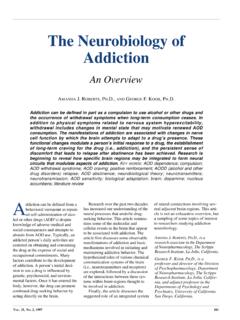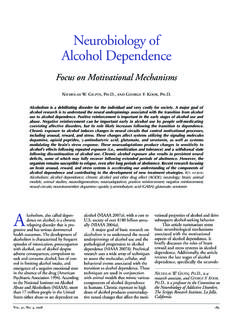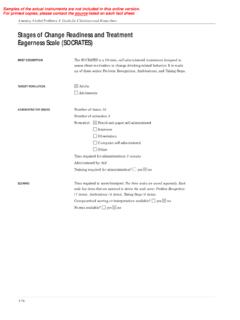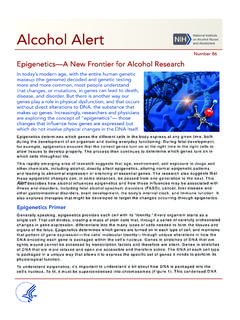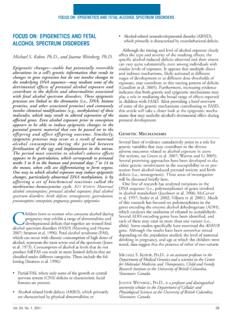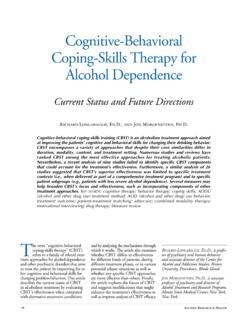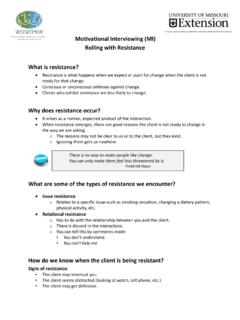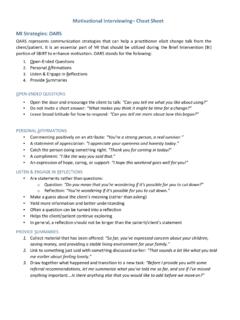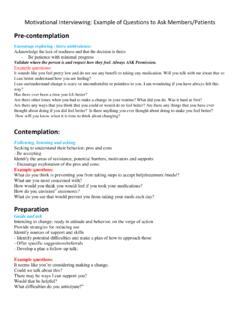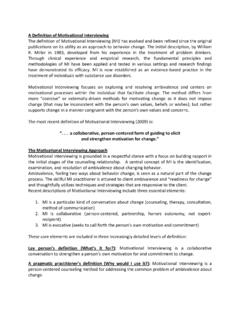Transcription of Motivational Interviewing Strategies to Facilitate …
1 A Clinical Guidefor PediatriciansVol. 20, No. 1 October 2007 Motivational Interviewing Strategies toFacilitate Adolescent Behavior Changeby Melanie A. Gold, DO, FAAP and Patricia K. Kokotailo, MD, MPH, FAAPM otivational Interviewing (MI) is a patient-centered, directive counseling style that builds on intrinsic motivation. When doing MI, the pe-diatrician creates a partnership with the patient to explore and resolve ambiva-lence about behavioral change. MI is often associated with the transtheoretical model first described nearly 25 years ago by Prochaska and DiClemente, who identified what they called stages of change, a continuum of readiness to change behavior. (Figure 1) Drawing in part on this understanding of the change process, William R. Mill-er and Stephen Rollnick collaborated to develop the Motivational Interviewing approach. In the stages of change model, the pediatrician facilitates change by matching counseling strategy to patient readiness.
2 Readiness is viewed not as a patient trait but as a fluctuating product of interpersonal interaction. MI refers to looking and seeing together from the patient s perspective rather than probing to extract information for di-agnosis and management. MI has been successfully applied to many types of behavioral goals (eg, diet and exercise, contraception, smoking, and drug use). whose behavior change is well estab-lished, typically for 6 months or longer (maintenance). If a patient resumes an unhealthy behavior, MI can be used to reframe relapse as a learning opportu-nity. MI is particularly effective for those who are not interested in change (precontemplation stage) or are think-ing about it but are not yet prepared to make a commitment (contempla-tion stage). MI can also help pediatri-cians working with adolescents who are firmly committed to change within 1 month (determination/preparation stage), whose behavior change has already begun (action stage), and those Comprehensive MI can be time con-suming, which is why it is not typically suited to the busy primary care set- Goals and ObjectivesGoal: To enable pediatricians to use a Motivational approach to counsel-ing adolescents about health behavior change Objectives: After reading this article, the pediatrician will be better prepared to: Describe Motivational Interviewing in the office setting and its role in behavior change Discuss Motivational Interviewing Strategies best suited to primary care practice Recognize when Motivational inter - viewing might be applicable Apply Motivational Interviewing Strategies in a variety of circumstancesMelanie A.
3 Gold, DO, FAAP, is an associate professor of pediatrics with certifi-cation in adolescent medicine at the Uni-versity of Pittsburgh School of Medicine. Dr Gold is director of family planning services within the Division of Adolescent Medicine at Children s Hospital of Pittsburgh and a Motivational Interviewing network K. Kokotailo, MD, MPH, FAAP, is a professor of pediatrics and director of adolescent medicine within the Division of General Pediatrics and Adoles-cent Medicine at the University of Wiscon-sin School of Medicine and Public Health. Dr Kokotailo is a member of the AAP Committee on Substance Abuse and the Adolescent Health Update editorial board. Supported through an educational grant from Merck & Co., on Adolescent Health2ting. However, adaptations of MI that include key Strategies described in this paper have shown promise for modify-ing teens risky or unhealthy behaviors. THE SPIRIT OF MIThe essential spirit of MI comprises 3 elements: collaboration, evocation, and autonomy.
4 Collaboration is a partnership be-tween pediatrician and adolescent that positions the adolescent as an expert about his/her own experiences, values, beliefs, and goals. E vocation is the use of open-ended questions and reflections to help the patient identify his or her intrinsic motivation for change. In MI, it is the adolescent s task to articulate and resolve ambivalence about change and the pediatrician s role to help the adolescent examine his or her internal conflicts about values, goals, beliefs, and occur. In support of autonomy, MI proposes that direct persuasion is not an effective way to resolve am-bivalence. Autonomy is the adolescent s respon-sibility to change his or her behavior and decide if, how, and when changes These elements underscore the pediatri-cian s respect for the patient s perspec-tive and behavioral choices. While re-spect for a perspective or a choice does not imply agreement, it communicates a premise: that the patient s beliefs and behaviors arise from a distinct combina-tion of needs, desires, and information (or lack of information) unique to him or OF MIPediatricians wishing to incorporate MI in their practices should become skilled in communication Strategies that have been shown to promote rapport and resolve ambivalence that is an ex-pected component of behavior change.
5 The 4 principles of MI are to: (1) ex-press empathy, (2) develop discrepancy, (3) roll with resistance, and (4) support self-efficacy in each patient encounter. Facilitate behavior change by express- ing empathy and accepting patient beliefs and behaviors. This is more effective than applying pressure through persuasion. Direct persuasion ( finger-wagging ) usually elicits re-sistance, especially among adolescents and particularly among those with an oppositional or defiant temperament. MI creates a nonjudgmental environ-ment that allows the adolescent to talk openly about behaviors and beliefs. Practice reflective listening to com-municate understanding. When your patient describes a behavior with a negative health impact, temporarily compartmentalize and hold off on voicing your concerns. Encourage an alliance by resisting the urge to give advice until it is requested or at least ask for the adolescent s permission before offering an alternative point of view.
6 Develop discrepancy by recognizing inconsistencies between current status and important goals or between cur-rent behavior and important values. Adolescents who are aware of these inconsistencies will usually attempt to make changes when they become aware of the consequences of current behavior. Ask the patient s permission to offer objective information about any discrepancies. Roll with resistance by recognizing that it is normal to feel ambivalent about behavior change. (Tables 1 and 2) Resistance usually occurs when the patient feels pushed to do something he or she is not yet ready to do. Signs of resistance include arguing, inter -rupting, denying there is a problem, ignoring the provider, missing ap-pointments, presenting too late for an appointment, or failing to complete requested tasks. Overt compliance with covert defiance is another form of resistance, signaled when the visit goes too smoothly and the adoles-cent seems to be agreeing too easily.
7 In MI, arguing and persuasion in the face of ambivalence are deemed counterproductive. These approaches, along with labeling the adolescent with his or her behavior ( a smoker ) FIGURE 1 Stages of Change ModelBased upon the transtheroretical model developed by James O. Prochaska, PhD, and Carlo C. DiClemente, PhD, which describes stages of change in terms of a continuum of readiness to change be expected to elicit a defensive response and increase resistance. If you see signs of resistance, shift to a new strategy. Change is most likely to occur when a problem is recognized and the patient believes in his or her ability to do something about it. Communicat-ing optimism about the motivated patient s ability to succeed at a desired change is a powerful facilitator. When you believe your patient is ready to change, support self efficacy by expressing your optimism. Point out, with permission, that change is not an all-or-nothing venture. Describe the patient s past successes and failures as learning opportunities.
8 Help the adolescent identify a range of effective alternatives for achieving his or her goals. WHAT DOES MI LOOK LIKE? MI employs open-ended questions and reflective listening to engage the pa-tient in a conversation about a behavior change intended to maintain health and/or decrease risk. MI increases the adolescent s receptivity and decreases resistance. This begins with rapport, and to that end, the pediatrician takes care to verify his or her interpretation of patient statements by paraphrasing and summarizing what is said. Finally, the pediatrician never offers information or advice without first requesting and re-ceiving permission to do so, and always seeks feedback on any suggestions. Strategies to Establish RapportReflective listening, open-ended questions, affirmations, and summaries are key MI Strategies used to build rap-port early in a visit. Reflective listening calls for a warm, nonjudgmental restatement, clarifica-tion, enhancement, or expansion of what your patient has said.
9 Younger adolescents may respond better to re-flections of emotion than to reflections of meaning. (Table 1) Open-ended questions encourage patients to talk about thoughts and feelings; they are phrased to prompt the patient to elaborate. With younger ado-lescents, it may help to begin with a few choices (Would you like to talk about X, Y, or Z today?) but always end with an open-ended question (..or maybe there is something else you would rather discuss? What do you think?). Affirmations express appreciation. (I really appreciate your being so honest with me, or That s an excellent idea!) Affirma-tions should be genuine and used spar-ingly; overuse sounds bring together thoughts or feelings that your patient has shared. If appropriate, talk about how you think they fit together. There are 3 types of summaries: (a) collecting sum-maries are used during the process of exploration and are meant to gather to-gether the patient s statements; (b) link-ing summaries are used to tie together what has been stated with something previously expressed in order to develop discrepancy; and (c) transitional sum-maries are used to prepare for a shift in focus (as when ending an encounter) by pulling together essential points to decide on the next Strategies FOR BRIEF OFFICE ENCOUNTERS Certain MI Strategies to enhance rapport or build motivation for change adapt well to office practice.
10 It would be unusual to use more than 1 or 2 of these Strategies in a single office visit. Ask Permission Before offering information or advice, find out whether it will be welcome. (Would you like to know more about _____? or Would it be okay if I told you what I thought about this?) This step is critical. If your patient declines, move to another topic. Elicit-Provide-Elicit (Ask-Tell-Ask)do. In that case, shift focus to the pro-cess of framing a realistic plan to imple-ment their ideas. Again, be sure to ask permission prior to giving information or advice, and after doing so, elicit the adolescent s reaction to what you have said (What do you make of this informa-tion/these options? How does this help you or change things?)Before launching into a lecture, first elicit what the adolescent already knows about the topic and/or options for behavior change. Many patients will already have the needed information or may have excellent ideas about what to Decisional BalanceAsk your patient to talk about the advantages and disadvantages of the change he/she is considering.



